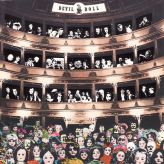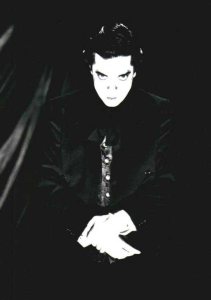Lists >
Devil Doll Discography
Created : 3 days ago
Last updated : 2 days ago
8 items
A list dedicated to one of my absolute favourite artists, Devil Doll. Commentary by Mr. Doctor himself.
Devil Doll does not belong to any genre as it is the faithful mirror of what I really am. It is no movie, no fake, no façade, no architecture. It is not done to please anybody or to sell records. I have no time nor interest in posing, and I despise a following of poseurs. All I care about is the amazing daily opportunity to open new doors, walking beyond the limit of my previous limit. If I think and talk and act and create in metres, I want to think and talk and act and create in centimetres, always re-setting my sensibility on the strength of new magnifying lenses. Hence, there’s no risk of riding a formula, as I am one and the same ever-changing merrily Tormented Man. | |
 |
Devil Doll 5 CD Box (2008) [Boxed set] Every musical idiom – Metal, Gothic, Prog-Rock, Classical or whatever – has its charm, as it puts the emphasis on a particular aspect of Music, such as the Energy for Metal, the Atmosphere for Gothic or the Structure for Classical or some Prog-Rock. But what really matters is Music itself, with its enchanting, magical power which transcends senses. A piece of music is remarkable or unremarkable regardless of its idiom: the problem only lies in the sensibility of the listener, who can open his horizons to odd, unheard, demanding sounds, or can remain stuck to the limited idiom of his tribe, to its stereotypes, which are the strict borders of his ignorance. In ancient Hebrew, the word Knowledge and the word Love, where one and the same word – because you can only love, appreciate, understand and be filled by the energy and the vibrations of what you KNOW. With a statement like – It’s not my TASTE – many hide their inability to transcend the narrow limits of their musical horizons. Exactly what Devil Doll has always fought against. |
 |
“The Girl Who Was… Death” was the first long-player to be distributed, because our debut album, “The Mark Of The Beast”, had been thought as a sort of “aural painting”, hence it was pressed in one single copy, to which I made myself the hand-painted artwork. One of the most memorable parts from “The Girl Who Was… Death” (introduced by an arpeggio of guitar followed by the lines “Who Are You Looking For… What Are You Looking At…” and by a breathtaking violin solo) was in fact transposed from “The Mark Of The Beast”: The lyrics are different, but the music was basically the same, although instrumental and vocal parts were reversed, in the sense that the instrumental parts of “The Girl Who Was… Death” were sung on “The Mark Of The Beast” and vice-versa. Recorded first-take-live-in-the-studio, “The Girl Who Was… Death” is Rockier and more immediate than any other Devil Doll album. Patrick McGoohan’s esoteric TV series “The Prisoner” was its loose inspiration. “The Prisoner” was McGoohan’s personal obsession as Devil Doll was mine: ONE man was in full control of the whole project, creating the concept, being the main actor, the screenwriter of the chief episodes, the director of some of them, the executive producer, the one who had even whistled the theme music to the series (later arranged by Ron Grainer) and the only person who knew what the whole thing was about, as the series, which had started as a bizarre spy-story, progressively metamorphosed into the realm of a nightmarish allegory on Man, at the same time Prisoner and Captor of Himself. |
 |
Eliogabalus (1990) “Eliogabalus” was almost entirely performed by the Italian section of Devil Doll and featured the title-track, plus “Mr. Doctor”, a composition which I had originally called “The Black Holes Of The Mind” and was inspired by the confession of an early Devil Doll fan, who told me she had been raped for many years by her older brother, a respectable “Doctor” who had eventually taken his own life jumping under a high-speed train. Among the crimes featured in the lyrics, the killing of “my brother” came from a dream I had, with “the unnameable who gave me the axe” being my mother. The rest of the story came from criminal cases found when I worked as a doctor in Law specialized in Criminology. The lyrics of “Eliogabalus” were about the most unknown of all Roman Emperors, Eliogabalus, who had been put to power when still a young boy because of his god-like beauty. He surpassed even the wildest borders of eccentricity and depravity and was soon killed. The Roman Senate ordered that no trace of his existence should ever left to posterity, hence his memory was obliterated by history until much later, when a brief profile was included in Aelius Lampridius’ “Storia Augusta”. In the Devil Doll track, I wanted the mad Eliogabalus as the symbol of the diverse or deformed who’s watching the world from behind the mirror. Where I always was. “The Black Holes Of The Mind” was played live many times before its recording (the only Devil Doll composition whose live performance pre-dates its studio recording) and the finale was taped late at night in a lousy bar just up the recording studio: you can still hear the cashier thanking the customers who buy cigarettes and pay. During the recordings of “The Black Holes Of The Mind”, I desired to also record “Eliogabalus”, a brand new track I had finished the day before entering the studio, so it had never been rehearsed. Furthermore, I had not thought of how to perform my vocal parts, but time was tight, so it was completely improvised. |
 |
Sacrilegium (1992) It is the most intense and claustrophobic of all the albums, and was recorded in dramatic circumstances during the cruel Yugoslavian war. Of the Italian half of the group, only drummer Rob Dani and pianist Francesco Carta dared to cross the Yugoslav border: the others quit the day before the beginning of the recordings, but Michele Fantini Jesurum joined at the last minute. He had been my school mate for eight years at secondary school and a master improvisator at the Pipe Organ, in the wake of his best friend and mentor, the old French organist (and a living legend of the instrument) Jean Guillou. “Sacrilegium”’s story was set in a pre-2nd World War Europe, with its smell of decadence, doubt and impending death, which was not dissimilar from the street atmosphere of those days. The social setting was mirrored by the suicidal personal anguish I was experiencing those days. As a result, my vocal performance is filled a desperation and a “no-tomorrow” lack of mental oxygen, which would be very hard to recapture. |
 |
As a companion to our sparse live performances, I wrote and filmed a silent movie entitled “The Sacrilege Of Fatal Arms”, a Dreyer-esque symphony of death whose soundtrack incorporated most of the music of “Sacrilegium” (although in a remixed form), plus thirty minutes of material specifically recorded to fit the images. The film and the soundtrack open with our rendition of the “Drina March”, a war song which had become the anthem of the cruellest faction during the recent Yugoslav war. |
 |
Dies Irae (1996) After the release of “The Sacrilege Of Fatal Arms”, I started to record an album which was going to be entitled “The Day Of Wrath”. In the middle of the recordings the studio was completely destroyed by a fire, whose origin is still shrouded in the mist of post-war vendettas. I saved my skin but not the tapes, of which only an unmixed cassette survived. We were consequently forced to re-start the work in a different studio. “Dies Irae” resurfaced from the ruins of “The Day Of Wrath” and is the most complex and artistically rewarding of the five albums reissued by Belle Antique. The concept acts on two levels: a series of paradoxical philosophic questions connected with love, life and afterlife, culminating with the killing of the loved person in order to guarantee her eternal life. Every passage is crystalline in its logic, though elliptically expressed in the flashes of poetic metaphors. The second level is personal. The lyrics, the artwork, the music feature over five hundred references, quotations, tiny clues which could reveal (to the most careful and prepared listener) all the influences which have fed my soul through the years. From a lyrical viewpoint I was particularly delighted by the way I managed to describe the killing (“and the virgin blade kisses, freeing, your white throat”) and by the last monologue of the man in a strait-jacket followed by the orchestral grand finale. From the musical viewpoint I still have a preference for the frightening “Incubus” section. In fact, I had composed and recorded two of them, one should have been featured on the European version of the album, and the other on the American pressing which was cancelled at the last minute. The material we recorded for “Dies Irae” filled altogether over 700 minutes of master tapes: the tiny clips which are part of the “Incubus” were in fact long compositions of which only a few seconds have been randomly chosen, illogically, as it happen in the worst nightmare, which is uncontrollable by reason. |
 |
Devil Doll Coffin set (2008) [Boxed set] I immediately made my second silent film, whose soundtrack incorporated 90 minutes of music from the “Dies Irae” sessions. I was tempted to release both, but the project was shelved when I started to compose a soundtrack to back Jean Epstein’s 1928 silent film “The Fall Of The House Of Usher”. The project was recorded, but was not performed as I decided to interrupt the collaboration with the Slovenian National Cinematheque, which had commissioned the work. Since then I have never stopped to write and record Devil Doll music, but in the past ten years I have lost interest in releasing the recordings. The stupefaction of the birth of a new composition is still the prime motivation, the rest is inessential. |
1







